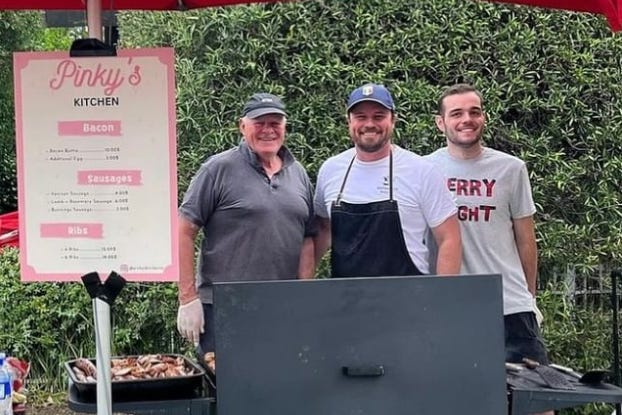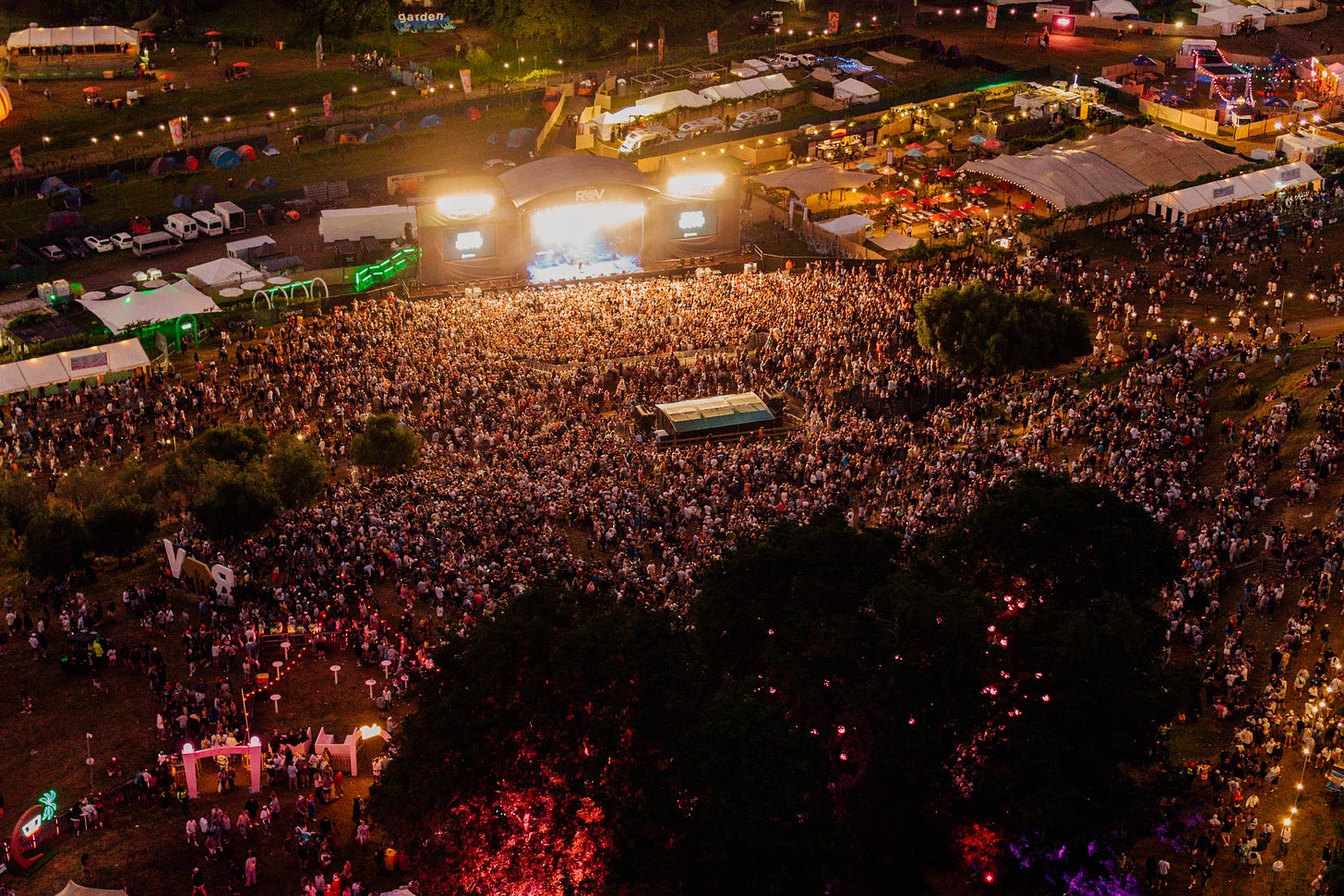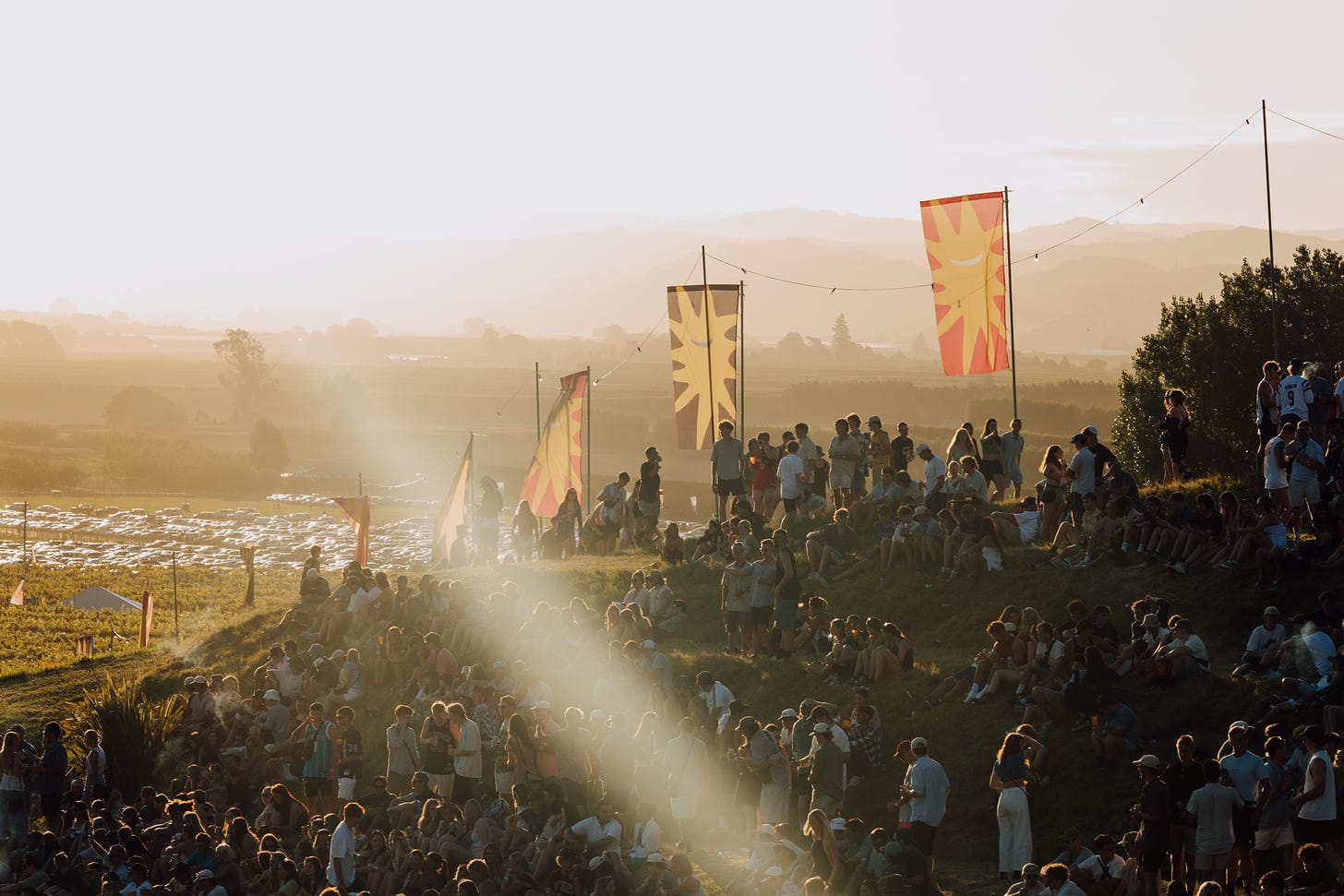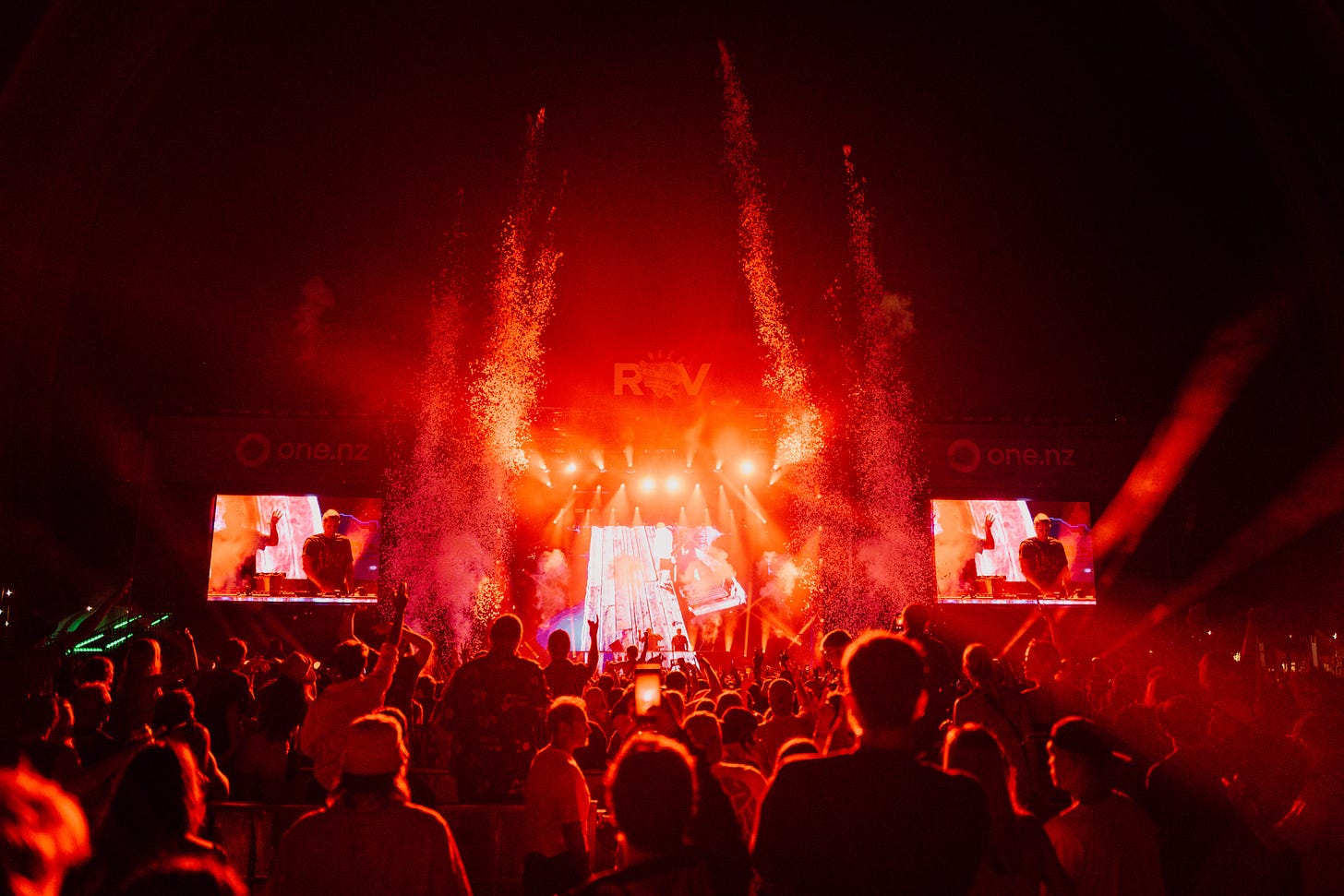'There is talk of a yardie': How a NZ music festival finally turned 21.
It's been a long and rocky road for Rhythm & Vines. I asked its founder how he did it, and he admits he has a few scars.
I smell Hamish Pinkham before I see him.
In a small Bayswater park on a warm December morning, adults sip coffees, kids munch on pastries and well-groomed dogs pick up the crumbs.
The aroma of bacon wafts across the grass.
It’s coming from Pinkham, who’s dressed in a full butcher’s apron and is clutching a pair of tongs behind a giant barbecue.
“The ribs are half an hour away,” he tells me, handing over a bacon and egg sandwich.
The part-time chef and full-time promoter readily admits he shouldn’t be behind the grill.
He doesn’t really have the time.
Pinkham is responsible for multiple music festivals this summer: his long-running three-day New Year’s celebration Rhythm & Vines in Gisborne, Auckland newbie Love Your Ways with Carl Cox, and the two-day January dance party Golden Lights, now into its third year with Foals and Peggy Gou on the bill.
Right now, at his Auckland-based promotions company Endeavour Live, things are about as hectic as they can get for Pinkham’s team of five. There are bookings to confirm, vendors to organise, stages and fences to erect and security guards to hire.
At the same time, they’re already at work on next year’s events. “We're booking acts nearly a year in advance. We're paying deposits. We're investing in infrastructure on site as well,” says Pinkham.
“Financially, it is a risk.”
Post-Covid, everything has become much more expensive. Equipment is harder to source. “If we wanted to get a stage now for February, it's too late,” says Pinkham. “It is just so hard to find gear … the cost of running these big outdoor festivals has gone through the roof.”
Competition – for gear, for headliners and for crowds – is huge. New Zealand’s festival landscape has bounced back from Covid to a state unlike anything we’ve seen before.
More than 90 music festivals are planned for our sprawling, stacked summer, a staggering number that even manages to puzzle industry veterans like Pinkham.
“There are lots of options out there,” he agrees. It could, he warns, become “a blood bath”.
It’s unlikely Rhythm & Vines will suffer. It’s easily among the biggest, with 23,000 expected to party amongst the vines at Waiohika Estate. It has history on its side, becoming a rite of passage for school leavers. Everyone has at least one Rhythm & Vines under their belt.
It’s been a long, rough road making it this far, but 2023 marks an important milestone. After several messy summers affected by Covid and wild weather, this is the year Pinkham’s OG finally celebrates its 21st, a magic number few large-scale, multi-stage festivals achieve in Aotearoa.
So Pinkham’s got one hell of a 21st party to organise. He’s busy. And yet, earlier this year, he was staring out over the empty park next to the Bayswater home he shares with his wife Roma and had a thought: wouldn’t it make a great spot for a market?
So he got to work, borrowing tents and picnic seats and pulling in favours from friends and family members. Then he set up an Instagram account, pulled his BBQ outside, and began smoking ribs and sizzling bacon on a Saturday.
The Bayswater Markets were born.
Several months in, Pinkham admits his homespun event isn’t yet making him any money. “It’s actually costing me money,” he says.
But a promoter’s got to promote. As the bacon keeps sizzling, a beaming Pinkham clearly just can’t help himself.
“How’s the sandwich?” he asks.
‘Everyone wants to be bigger and bigger’
It started with a bunch of mates giving it a go.
Three University of Otago friends wanted to celebrate New Year’s in style but couldn’t find anywhere to do it.
One of them, Andrew Witters, offered up his family’s Gisborne vineyard. Along with Pinkham and Tom Gibson, the trio booked The Black Seeds to play.
Nearly 1800 people showed up.
The following year, word had spread. Up to 5500 people arrived.
By 2006, 15,000 people were coming to experience the trio’s New Year’s Eve festival.
By 2008, it had expanded to become a three-day event.
By 2010, Pharrell’s N*E*R*D was headlining Rhythm & Vines in front of 25,000 people.
By 2011, the South Island island had its own version, Wanaka’s sister festival Rhythm & Alps.
At that point, Rhythm & Vines seemed like an unstoppable juggernaut, one that lived up to its billing as New Zealand’s answer to Coachella. It was the place artists wanted to play, and the venue punters wanted to be seen celebrating New Year’s.
I remember arriving in 2008 for the first time and marveling at the size of the thing. Throngs of people drank cider on the sides of grassy hills, made out in amongst the grape vines, and slid down a huge water slide in the middle of it all.
It looked like no other New Zealand festival I’d been to. From a bar on one side of the stage, I watched Santigold perform while chatting with members of the Scottish rock act Franz Ferdinand.
That same year, Flavour Flav swung his giant clock around with Public Enemy on the main stage and P-Money performed in a forest. When the clock struck midnight, Shihad’s Jon Toogood counted the crowd down as fireworks erupted over our heads.
Rhythm & Vines had grown so large that Gisborne and its population of around 40,000 couldn’t cope with it, says Pinkham.
“Petrol stations were running out of petrol and Burger King ran out of cups,” he says.
It couldn’t keep up with its own growth. “Everything doubles: double security, two main stages … bigger budgets means bigger artists.”
There was, Pinkham soon discovered, a downside to all that biggering. “The hills were crawling [with people] … if you get bigger you get more trouble. We had a lot of riff-raff.”
He’s right. At the same time I was hanging out with Franz Ferdinand, someone jumped on my car and caved the roof in.
By 2014, more than 30,000 people were coming to Rhythm & Vines. It got so popular a a rival festival, BW Campgrounds, sprung up. It grew fast, and soon many were heading to Gisborne just to experience Rhythm & Vines’ rowdier, drunker cousin.
That’s when the real trouble began. Organised by Pinkham’s co-founder Witters, it split Gisborne’s festival audience and caused a rift between the Rhythm & Vines co-founders. Then fires and riots broke out.
All this is captured in the warts-and-all documentary Road to Rhythm that reveals behind-the-scenes spats, splits and financial issues. It shows just how close Pinkham’s festival came to imploding over those tumultuous years.
It’s a great watch – and it’s all free…
When the documentary came out in 2018, Pinkham told me it was “cathartic” to look back at the chaos and let it all go.
“There was a point we had too much on our plate. We collectively decided to throw the towel in,” he said at the time. “It puts it in perspective how hard it's been over the years.”
There have been other issues.
In 2017, footage of a woman being groped caused outrage.
In 2021, the event was postponed, then cancelled, over an Omicron outbreak.
Pinkham and his staff had spent many days trying to nab spots in MIQ to get their headliners through the strict isolation process and into the country. “That was a real kick in the guts,” he says.
Last year, the promoter put his foot in his mouth after defending his choice of Dizzee Rascal, who was convicted of assaulting his ex-partner, as a headliner.
You don’t survive this long without earning a few scars, and Pinkham has plenty.
He admits he’s a little more careful with his words these days.
If you ask him how he’s managed to last this long, he’ll give you a one-word answer: “Tenacity.”
Get him to expand on that and he’ll recite what sounds a little like a press release: “I realised what was worth fighting for. Nothing happens by chance and there has been a lot of commitment and managing risk to get the event back into a place where it could continue its legacy.”
Sometimes though, you can still catch Pinkham off guard, and his promoter braggadocio can sneak through.
“It’s a great recipe,” he tells me about the ingredients that go into putting together Rhythm & Vines.
“It’s a world class event … we know we’re not polishing a turd.”
‘They’ve got to get their own bags off the tractor’
When Rhythm & Vines approaches a big-name headliner to come and play, Pinkham and his crew have one trump card to play.
Gisborne.
“It’s a good leveler,” he says. “They fly in with their bravado and their ego [and] they've got to get their own bags off the tractor. There's tumbleweeds on the tarmac. It's quite humbling. People are pulled back to Earth.”
After a pōwhiri, someone from Pinkham’s team will pick the artists up in a bus, then drive them up a long driveway, past a pond and through the trees to Waiohika Homestead.
There, champagne is waiting on the lawn, a pool is ready for them to swim in, and snacks are available on request.
Upstairs is their green room with a balcony overlooking the festival site. “You’ve got Chance, the Rapper, or this year Central Cee, overlooking their kingdom,” says Pinkham.
Sometimes, that backstage area can result in some strange celebrity meet-ups.
“Iggy Azalea was there with Playboi Carti,” says Pinkham about his 2019 event. “Miike Snow (singer Andrew Wyatt) turned up with Mark Ronson. People get on the piano and jam away. They’ll get a bit of an acapella going.”
That, says Pinkham, is the biggest reason Rhythm & Vines has lasted this long. Just like the fans out partying amidst the vines, artists get to have an experience they can’t get at any other festival.
“It’s all the elements that add to that escapism. It's the holiday period. You're far from home,” he says. “People can really lose themselves in this magical Wonderland.”
Rhythm & Vines has scaled back from its peak. Audience numbers are capped at 23,000. It sells 50% of its tickets before releasing its line-up. Like most years, this year is heading for a sellout.
While Pinkham admits there’s still work to do, it’s among the more gender diverse festivals on offer this summer, with Becky Hill, Gin Wigmore and Lady Shaka performing next to the big-name male headliners.
It’s become boutique, and a little bougie. Punters can pre-purchase camping spots with tents already set up, and buy VIP tickets that include backstage cocktails and day beds.
Pinkham hopes one thing happens at New Zealand’s biggest ever 21st: “[I want] people to leave that place happy.”
There may be hiccups. There probably will be. Our festival season has already off to a chaotic start, with Sublime with Rome pulling out of its New Zealand tour, leaving seven events scrambling for a headliner.
Meanwhile, Laneway is battling police, the council and health officials over its liquor license for its Waitangi Day event. So too is Rhythm & Alps.
Surely, in amongst the chaos of running a festival, there has to be time for Pinkham to celebrate, to mark the achievement of a rare milestone, a music festival that’s managed to survive and make it to its 21st?
Pinkham responds in PR mode again. “It’s a nice quiet moment to share with my wife who has been a huge support to me following my dreams of the festival,” he says. “And a few back slaps with the key team who work hard to make it happen each summer.”
Push him, though, and there might be something else on offer, a traditional moment to really mark the occasion, one that could end his night in a very bad way.
“There is talk of a yardie,” admits Pinkham. “But I’m not sure that will be appropriate.”
Thanks for reading Boiler Room. If you’d like to support the work I’m doing here, please consider becoming a paying subscriber. To those that already are, thank you!












Interesting there's no mention it's now 80% owned by Live Nation and while Pinkham is still a director his trust only owns 10%